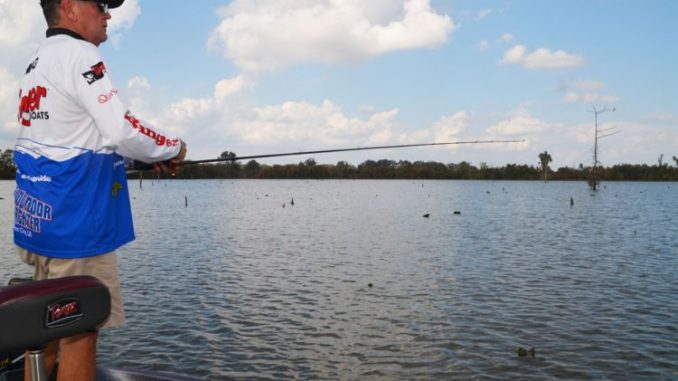
The Red River Waterway system offers a huge array of bass habitats, including stump fields, backwater lakes, the original river’s banks, rock piles, log jams, reeds (cut grass), oxbow ridges and shorelines, as well as lily pad fields that have bounced back after the floods.
“You would have to fish this one pool for months and months to fish everything,” chuckled Trent Toups.
To make things easier for anglers new to the system, Charlie King broke the year into four distinct seasons and shared his secrets for the best production in each.
Winter
King defined winter as beginning after Thanksgiving when water temperatures sink below 60º F, extending through late January. Bass have moved from the river into backwater lakes in the fall following the movement of shad.
“This is when I slow down my presentation and throw creature baits like a 5-inch Mister Twister Poc’it Hawg or a half-ounce Santone jig with a Mister Twister Buzz Bug,” he said. Go-to colors are black/blue or black, brown and amber for jigs, and watermelon red or black with blue flake for the Buzz Bugs.
A favored tactic on warm January and even February days is to punch mats of frozen water hyacinths using Mister Twister Poc’it Craws on 1-ounce or larger tungsten jigheads with 80-pound test Vicious No-Fade braided line. “That’s when I catch my biggest fish,” he winked.
Although he avoids the river proper that time of year, he will target stumps in 7 or 8 feet of water in oxbow lakes, as well. Again, he uses jigs or creature baits, and stressed the lures must be fished very slowly.
Spring
Spring in Charlie King’s book begins in February, when water temperatures warm enough to approach 60º, and lasts through April and even early May. Bass are moving shallower, in 1 to 3 feet of water, but are still in the backwaters where they spawn.
He works what he calls “ridges” — firm bottoms that are the old flooded shorelines of oxbow lakes that are shallower than the backwater swamps on one side and the bed of the oxbow on the other.
His targets are stumps and lily pad beds. The lily pad beds are good targets because they are generally found on hard bottoms, which are good for spawning. They cannot be located by looking for the pads, because at that time of year their only visible features are the stubs of brown stems.
King’s go-to lures include a Mister Twister Poc’it Hawg, a 3/8-ounce Strike King spinner and a 5-inch Mister Twister Comida worm with a Keith Poche Power Spinner screwed into its tail.
He uses the same colors for Poc’it Hawgs as in the winter with one additional color added, green pumpkin with a chartreuse-dipped tail. Dip is used because water colors are often murky in the spring.
His Poc’it Hawgs are Texas-rigged, and pegged on 3/8- or 5/16-ounce tungsten weights. His rationale for pegging the weight is that “when the fish hit it, they nail it.”
His favorite configuration for the Strike King spinner is a chartreuse and white skirt with double spinners, one a silver Colorado blade and the other a gold willow leaf blade.
Comida worms are Texas-rigged as well, with a 1/16-ounce weight and a 4/0 offset Owner hook. He uses one color: black/blue flake. The Keith Poche spinner can be either willow leaf, or Colorado-shaped.
“I don’t throw a lizard, a wacky worm or a trick worm,” he said emphatically. “But you have to remain flexible enough in the spring to revert to winter-style slow-fishing if conditions call for it.”
Summer
Summer extends from early to mid-May and goes to the end of August. Hot air and water temperatures slow the fish down and make them feed at night.
In early summer, King still hits lily pad beds in backwaters, leaning heavily on use of a bluegill color 3/8-ounce Strike King KVD Swim Jig, paired with a watermelon red, 3-inch Gary Yamamoto curly tail grub. “Always put the grub on the hook with the curly tail facing down,” King stressed.
On the lily beds, he also often uses a brown/black Live Target Hollow Body frog.
When water temperatures heat up, King gets out of the backwaters and focuses on the Red River itself, fishing crankbaits on river rocks, wing dams, revetments and jetties. On the river, he looks for current breaks where backwaters are draining into the river, or islands or points that create breaks.
He also hits deepwater (7 feet or so) stumps in oxbows, but if they are not productive he quickly moves to the river. “The summer is all about playing the currents,” he noted.
“Summer is a bitch here.”
Fall
Fall fishing begins in September and lasts until around Thanksgiving, and King calls it his favorite season. The weather is stable, so bass can be patterned easier than in other seasons, and he can use his favorite baits: spinners and crankbaits, what he calls his “running baits.”
During the fall, he fishes both backwaters and the river. In backwaters, he targets the same “ridges” he did in the spring, essentially the stumpy former shores (before flooding by the locks and dams) of the system’s numerous oxbow lakes.
Although the tops of the ridges only average 2 feet of water on them, King’s primary pattern is to work the drop-off from the ridge tops into 7 to 10 feet of water in the old beds of the oxbows.
He especially works stumps on the drop-offs. “Current maps aren’t of much use in finding these spots,” he counseled. “You have to fish them to learn them.”
In the river, he fishes rocks, cut banks, log jams and current eddies, leaning more on lures like Poc’it Craws and Sweet Beavers, Texas-rigged with 5/16-ounce tungsten weights pegged on the line.